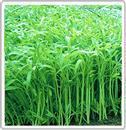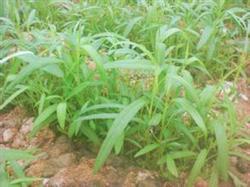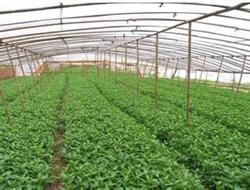Pollution-free Cultivation of Water Spinach

1. Cultivation areas: soil (including ph, cadmium, lead, mercury, arsenic, chromium, BHC, DDT), water quality (including ph, cadmium, lead, mercury, fluorine, arsenic, hexaphenol chromium, cyanide, chloride), atmosphere (nitrogen oxides, sulfur trioxide, fluoride), etc. all meet the requirements of the Environmental Standard for pollution-free Agricultural products in one producing area. Second, sowing and raising seedlings: implement vines to raise seedlings, use the vines selected last year to protect the safe overwintering and then insert them into the seedling box. Generally sowing in late February, according to the width of 1.5 meters, ditch width of 20 to 25 centimeters of the specification of the whole field, apply sufficient fertilizer, sow seeds in a full box, sowing all kinds of vines 150 kilograms per mu of seedling bed. After sowing, cover with plastic plastic film for heat preservation and moisturization, and remove the plastic film after the seedlings are unearthed. When the seedling is about 30 cm high, it grabs the vine to promote the adventitious roots downward, draw long lateral branches upward, and then plant them with side branch cuttings of a certain size. Third, fertilization and transplanting: asparagus is not strict on soil conditions, so it is appropriate to choose low-lying, moist and fertile clay soil for cultivation. The base fertilizer is mainly organic fertilizer and phosphate fertilizer, which can be sprinkled with a certain amount of plant ash. The cultivation specification is 30cm between rows and 1520cm between nests. In addition, the tip of about 15 cm can be cut and propagated again during the growth period. As long as the soil moisture in the cutting field is suitable, the shoot will quickly grow adventitious roots and pull out new shoots. Fourth, field management: in the early stage, the soil should be ploughed and loosened in time to improve the ground temperature. In summer, the temperature is high, the plant grows fast, the fertilizer and water demand is large, and the water should be watered frequently (dry air, insufficient soil moisture, which can easily lead to the increase of hollow cabbage fiber and affect the yield and quality), and combined with watering for topdressing. After the first harvest, 15 kg of urea or 20 kg of diammonium phosphate was applied per mu, and topdressing was applied with irrigation. After that, topdressing fertilizer was applied every 20 days or so, and urea was applied 3 to 5 kilograms per mu. When the temperature turns cool in autumn, it is necessary to plough and weed in time, and pay attention to the control of red spiders and other pests. In addition, the branches should be thinned when there are too many lateral branches and the branches are crowded and thin, so that the growth of the branches is balanced, the ventilation and light transmission is good, and the product quality is improved. Fifth, harvesting technology: timely harvest is the key to high yield and high quality of asparagus. In production, it can be harvested when the seedling height is about 25cm and 35cm. In the first and second harvest, there should be 2-3 nodes at the base of the stem to facilitate the germination of new buds, promote lateral branches and strive for high yield. After harvesting for 3 or 4 times, the plant should be reharvested, that is, only 1 or 2 books should be left at the base of the stem to prevent the occurrence of too many lateral branches, resulting in weak and slow growth.
- Prev

Cultivation techniques of asparagus in plastic greenhouse in winter
Asparagus is widely cultivated in all parts of our province, and it is the main green leaf light vegetable in summer and autumn. Puccinellia oleifera likes high temperature and humidity, has strong heat tolerance and is not resistant to frost, but its stems and leaves die in case of frost. The optimum temperature for growth is 25: 30 ℃, and the growth is stagnant below 10 ℃, so plastic greenhouse should be used for out-of-season cultivation in winter. First, the variety.
- Next

Winter management measures of asparagus greenhouse
The main results are as follows: 1. Turn the soil deeply, apply enough base fertilizer and wet the soil. Adjust the temperature according to the needs of the plant, spray the new high-fat film can effectively prevent the aboveground water from evaporation, shorten the slow seedling stage, make the plant quickly adapt to the new environment and grow healthily. 2, reasonable watering, timely fertilization, ploughing and weeding,.
Related
- Where is it suitable to grow horseradish in China? it is expected to see the middle altitude horseradish in Alishan.
- How to prevent tomato virus disease reasonably? (Control methods included)
- Many people like to plant towel gourd on the balcony. What are the main points of this method and management?
- What crops can chili peppers be mixed with?
- Fertilization techniques and matters needing attention in Tomato
- What are the grafting techniques for peach seedlings in spring?
- Harm and control methods of root swelling disease of Chinese cabbage
- What are the pests of sweet potatoes? How to prevent and cure it?
- Symptoms, causes and Control methods of navel Rot in Tomato
- The cause of "Cucumber rotten bibcock" in Farmers' planting Cucumber and its Control Plan

